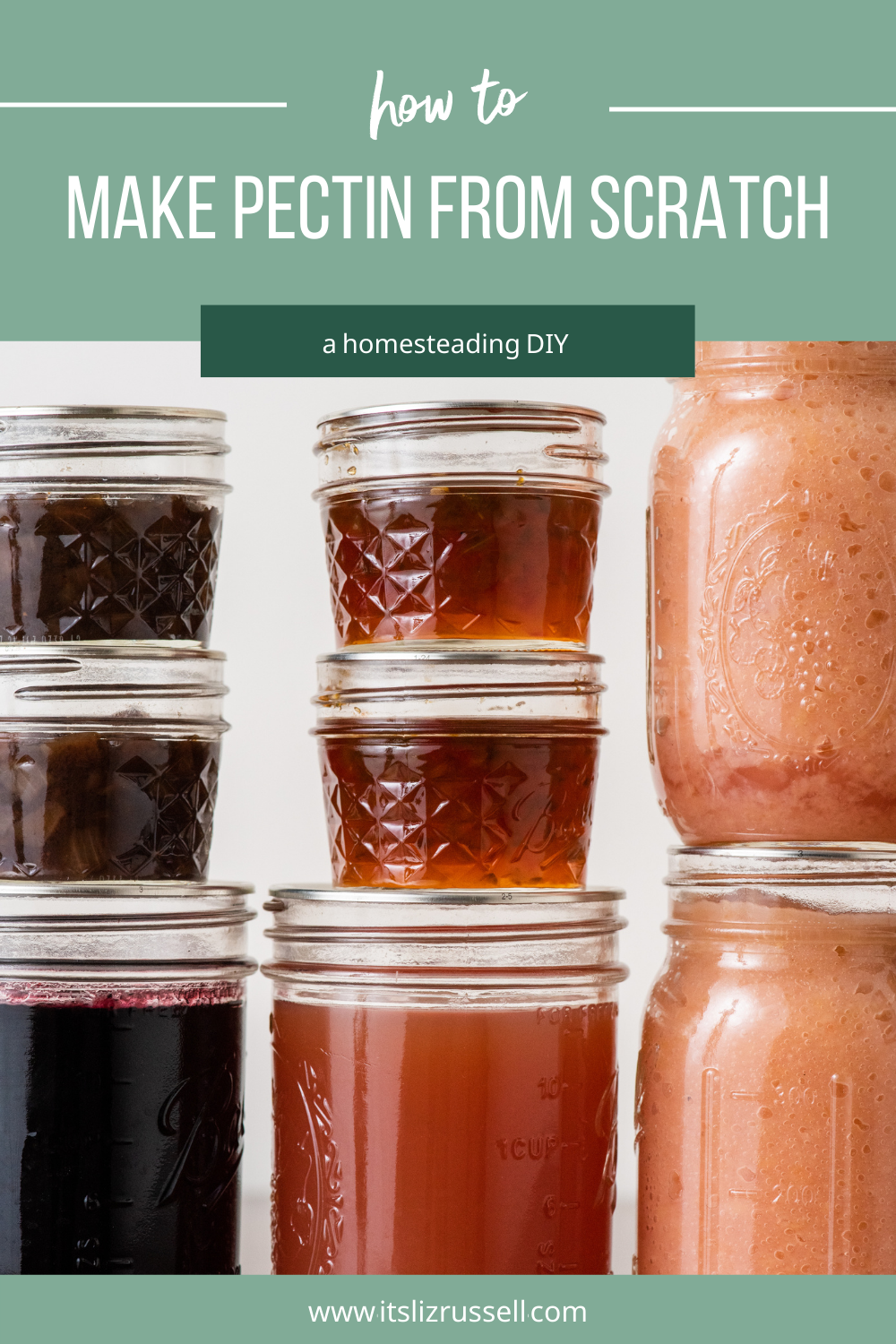Make Your Own Pectin from Scratch! Here's How...
Pectin. So many people haven’t heard of it and the ones who have tend to think of it in it’s blue or pink little boxes—a few pouches of powder or liquid that, by some science or magic, turns your raspberries into jam. By the middle of the pandemic, those boxes were missing from store shelves; what was available cost more than the fruit you’d make your jam with - and that had traveled internationally. It was also about that time that I started shouting this from the rooftops: you can make pectin yourself!
WHAT IS PECTIN ANYWAYS?
Pectin is a key ingredient in jam, jelly, and other recipes as a thickener. It’s a naturally-occurring, complex starch that is found in fruits, vegetables, and other plants in varying amounts. Some fruits - like apples - have more of it than others. As processing pros, our goal is to leverage that pectin by either removing it from its source and storing it, or by using those high-pectin foods in the recipe in which we need the pectin.
So what does that mean for my summer jams or jellies? It means they either have to include some high-pectin foods like apples and citrus in the recipe, or I need to extract pectin from those foods and add it in.
That’s right - I could just include the apples and make some apple-raspberry or apple-strawberry or apple-whatever jams. But I don’t always want to, especially if the volume of apples needs to outweigh the rest to get the consistency right. So extraction is another option in the old toolbox, and it goes a little something like this.
Important note: before you start, extracting pectin is a process that takes a few hours. You won’t be active every minute of those hours, but you should plan to be home and near your stove so that you can stir the mixture and keep an eye out for color changes. I highly recommend reading the instructions in full before you get started!
HOW I MAKE PECTIN ON THE HOMESTEAD
This will stress so many of you out – but I don’t use measurements to do any of this. Don’t let that stop you; ambiguity works in this recipe. Just use your basic senses – sight especially – to see how you’re doing.
To start, you need to gather apples. I use small crabapples – bright pink and the size of large cherries – that are present all over our farm. They’re perfect. Because they’re small and tart, they are an excellent source of pectin as well as acid - two important components in a jam recipe. If you don’t have crabapples specifically, any small apples will do; these are typically tart and underdeveloped – which is good. Larger apples also have pectin, but it may take you more of them to get the concentration you want here.
Ingredients:
Small, immature apples - crabapples are especially good!
Water
Rubbing alcohol (don’t worry - you will not ingest this, at least not if you follow these instructions).
To make two pints of pectin, I usually gather about ½ a peck of apples, or 5 pounds of apples (this seems to translate to about 16 cups, or 1 gallon if you’re trying to use a measurement that you have on hand – lord knows I’ve done that!). Because the amount of pectin you get will vary a lot by the makeup of the apples, this is not exactly a perfect measure. I even have it change from year to year. Just start somewhere. Pectin goes really far so even a single pint can be meaningful.
Once gathered:
Remove the stems with a little twist and wash the crabapples.
Chop up the crabapples. You don’t need to peel or remove seeds - this happens later. (hallelujah!).
Put them into a stock pot big enough to fit the apples, with room to spare, and add enough water to float the apples.
Bring the water to a rolling boil. Once reached, turn the heat down to a simmer and continue to boil the apples, stirring every half hour or so, until they’re reduced to mush and have turned a deep amber color. Depending on your volume, this can take between one and two hours, or maybe even more if you really go wild. Apparently, I have not. :D
When ready, you will want to pour the contents of the pot into a fine strainer or cheese cloth to strain out the liquid from the solids. This is where your skins and seeds will end up being removed from your pectin! Don’t be afraid to really squeeze the pectin out of the apple mush. There ends up being so much left in there that you don’t want to waste! *Amazing surprise that I’m going to ruin for you right now: The liquid you’re straining off will actually be a bright, pretty pink!*
Return the strained liquid to the stove top and continue to boil it down until it’s concentrated enough. Here’s how you’ll know: take a bit of pectin and put it in the fridge until it’s cool - just a teaspoon or so. Meanwhile, get out your rubbing alcohol and pour a half inch or so into a dish. Once the pectin in the fridge is cold, get it out and drop it into the rubbing alcohol and mix it. If the pectin is concentrated enough, it should form a jelly ball (which is really fun to play with). If it’s not done, just keep boiling until pectin passes the rubbing alcohol test. Again – use your senses here. If it looks like a bunch of jelly and squishes like a bunch of jelly when you poke it, you’re good!
STORING PECTIN
Once made, pectin can be stored a few ways. I can’t really comment on how shelf-stable it is outside of my experience. This is what I do personally to ensure safety:
Freeze the Pectin
Pectin can be frozen and thawed for use. I’ve done this with no issue in the past. Once important note though: you don’t often use a TON of pectin in recipes, so I find that I waste more of it if I freeze it in pint jars and thaw it; it’s simply too much thawed pectin for me to use in one jam-making session. Instead, I recommend using half pints or smaller so that you’re only taking out what you need when you need it.
Can the Pectin
I prefer to can the pectin to save precious freezer space. Because pectin is super acidic, you can can it in a water bath on your stove top. Again, I recommend using a jar size that makes sense for how you will use your pectin. To do can pectin:
Clean your jars properly. (This isn’t a post for me to tell you how to do that, but if you need help, Google it or reach out!).
Pour the pectin into the warm jars for a hot pack. I almost always do this right after the pectin passes it’s alcohol test, because it’s already warm and I can just keep working in the same messy kitchen.
Leave ½ inch of headspace in each jar.
Process in a water bath for 10 minutes if you live at 0-999 foot elevation. Add 5 additional minutes for every 1,000 foot of elevation after (for example, I’m at about 1,200 ft. elevation, so I’ll process for 15 minutes).
USING YOUR NEW PECTIN!
“I use about ¼ cup to 6 tablespoons of pectin per full jam/jelly recipe and that typically works.”
One big “issue” with not buying store-bought pectin is that you really have limited instructions to follow once you actually want to use your pectin in a recipe. Here’s how I use my pectin (knowing, again, that our concentrations will vary). Most things you’ll find online say ¼ cup of pectin for each cup of fruit. I’ve found that that’s way too much to use and that your jelly will be quite hard (or maybe my crabapples are just super pectin creators. Not sure). So instead, I use about ¼ cup to 6 tablespoons of pectin per full jam/jelly recipe and that typically works. I’ll always start on the low end with only a quarter cup and then add a tablespoon at a time and look for the jam to set before adding more. Use your jam making skills to assess, and again, rely on those senses to determine what done looks like.
And there you have it – a great way to use up those crabapples, gain a little more food security, and practice cooking on instinct. Let me know how it goes!

